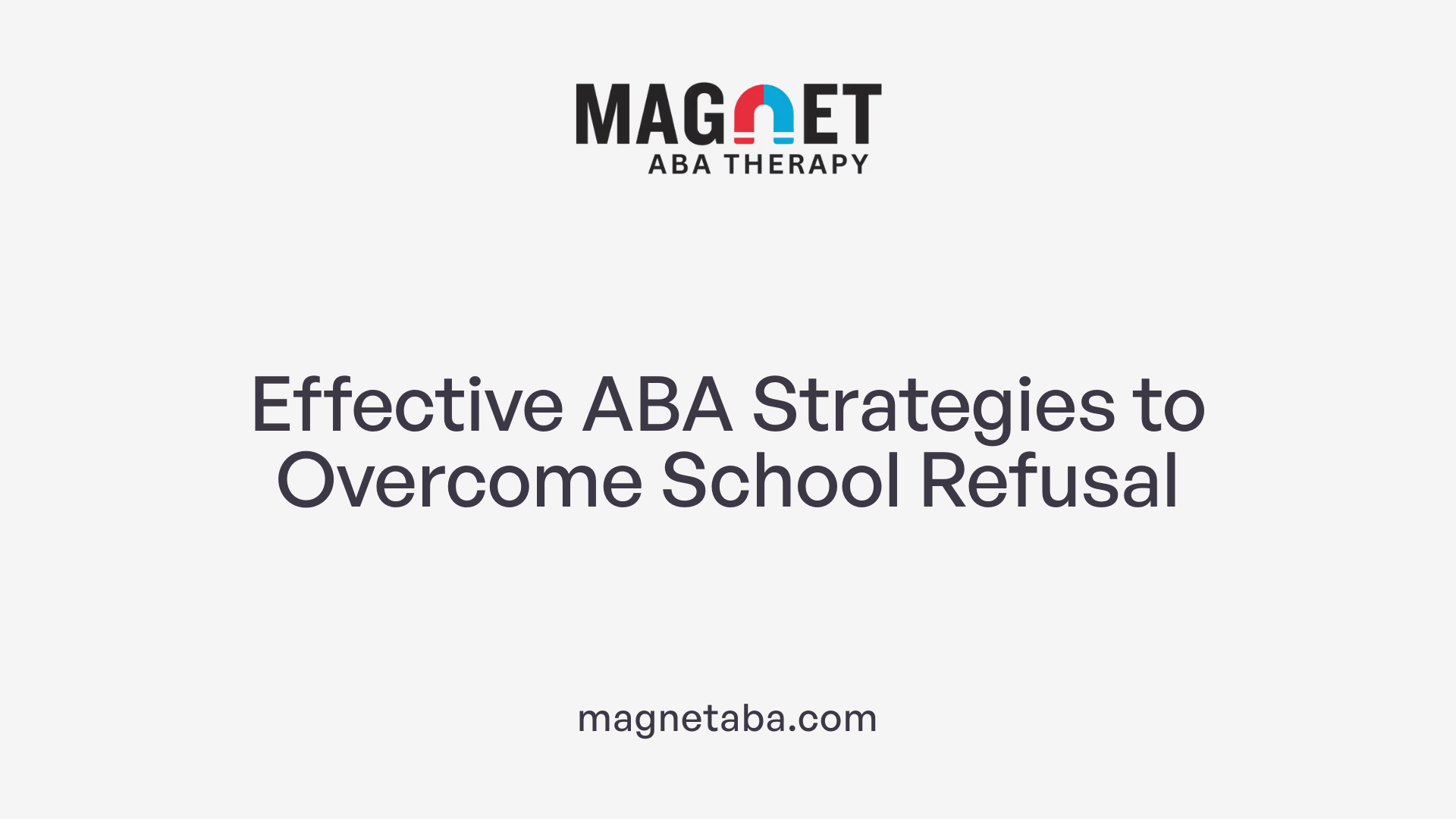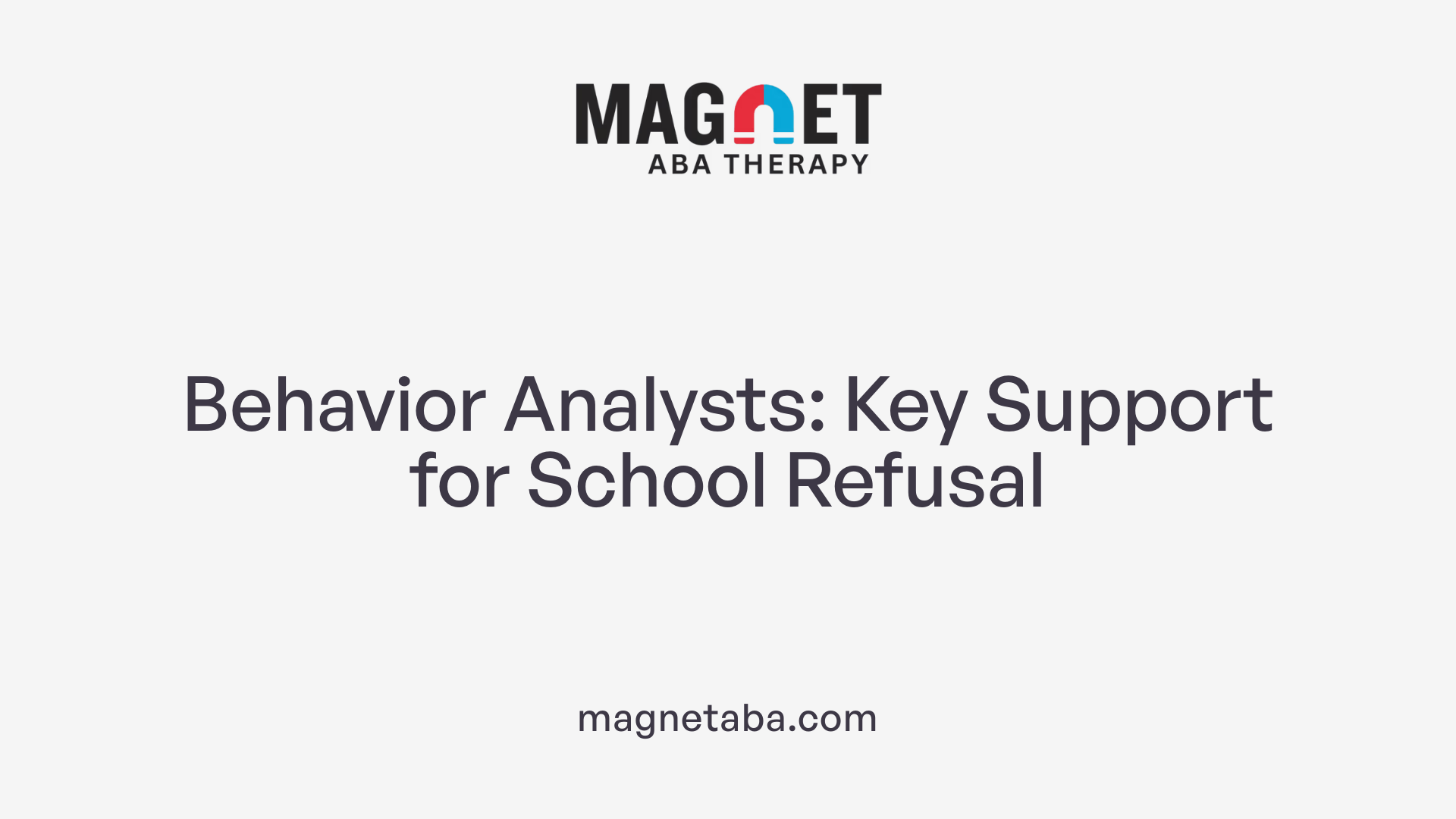Understanding and Addressing School Refusal Through Evidence-Based Methods
School refusal is a multifaceted issue impacting children across developmental areas, often intertwined with emotional and behavioral challenges. Applied Behavior Analysis (ABA) offers tailored, evidence-based strategies designed to identify root causes, modify behaviors, and promote successful reintegration into school environments. This article explores how ABA tools and techniques, alongside assessment methodologies such as Functional Behavioral Assessments (FBAs), help clinicians, educators, and families collaboratively address school refusal, ensuring children receive the support they need to thrive academically and socially.
Core ABA Strategies for Managing School Refusal

What are effective ABA tools and strategies for managing school refusal?
Managing school refusal through Applied Behavior Analysis (ABA) involves a comprehensive and tailored approach. One of the foundational tools is the Functional Behavior Assessment (FBA), which helps identify the specific reasons behind a child's avoidance behavior. Tools like the School Refusal Assessment Scale-Revised (SRAS-R) are often used to pinpoint whether the child's behavior is driven by anxiety, attention-seeking, escape from difficult tasks, or other functions.
Once the function of the behavior is understood, interventions can be designed to address the root cause. Gradual exposure or desensitization is a common technique, where children are slowly introduced to the school environment starting with simple visits, such as being in the school yard without attending classes, and gradually progressing to full-day attendance. Reinforcement strategies are essential—praising and rewarding attendance, even in small increments, motivates children to overcome their fears.
Environmental modifications also play a significant role. Creating a sensory-friendly environment, providing quiet spaces, and reducing overwhelming stimuli can help lessen anxiety triggers. Tailoring academic expectations through accommodations and supports, such as visual schedules or assistive technology, can make the school setting less intimidating.
Effective collaboration among parents, teachers, and mental health professionals is critical. Consistent communication ensures that everyone reinforces the same positive behaviors and strategies, fostering a stable, supportive environment for the child. Parents can learn reinforcement techniques and troubleshooting strategies, while teachers can implement gradual exposure plans and accommodations.
In some cases, ABA interventions are combined with cognitive-behavioral therapy (CBT), which addresses underlying anxiety symptoms. When necessary, medication like SSRIs may be prescribed to manage clinical anxiety or depression.
Overall, a multidisciplinary, individualized approach that incorporates functional assessments, behavioral strategies, environmental adjustments, and collaboration maximizes the likelihood of successful reintegration into school.
Assessment Techniques to Uncover Underlying Causes of School Refusal

What assessment techniques, including functional behavioral assessments (FBAs), are used to understand school refusal?
Understanding why a child refuses to go to school is a vital step toward effective intervention. Several assessment methods are employed by behavior analysts and mental health professionals to uncover the reasons behind school refusal behaviors.
One prominent approach involves structured interviews, such as the Anxiety Disorders Interview Schedule (ADIS), which helps identify anxiety-related issues that may contribute to school refusal. These interviews are comprehensive and involve discussions with parents, teachers, and the child to explore emotional and behavioral patterns.
Questionnaires and rating scales are also essential tools. The School Refusal Assessment Scale (SRAS) and its revised version (SRAS-R) are widely used to determine the function of school avoidance behavior. These scales help identify whether the child's refusal is driven by anxiety, social pressures, attention-seeking, or pursuit of tangible rewards outside of school.
Behavioral observations form another key component. Observers may monitor attendance behaviors across different settings or under varying conditions. For example, noting the child’s behavior when they are encouraged to attend gradually or when faced with different levels of academic demand can highlight specific triggers or reinforcement patterns, such as avoidance, escape, or attention-seeking.
Reviewing school records, including attendance logs and behavioral incident reports, provides essential context. These records can reveal patterns of avoidance, physical complaints like stomachaches or headaches, emotional signs such as anxiety or depression, and specific moments when refusal episodes are most prevalent.
Perhaps most importantly, the process of Functional Behavioral Assessment (FBA) integrates all collected data—observations, interviews, rating scales, and records. The FBA aims to understand the purpose or function of the school refusal behavior. Is the child trying to avoid negative feelings associated with school, social situations, or academic demands? Or are they seeking attention or tangible benefits outside of school?
The comprehensive FBA process involves several steps:
- Gathering information through interviews, observations, and record reviews.
- Analyzing data to identify triggers and consequences.
- Hypothesizing the function of behavior.
- Designing targeted interventions aligned with the identified function.
By understanding the underlying reasons for school refusal through these assessment techniques, practitioners can develop personalized strategies that reduce anxiety, promote attendance, and improve overall well-being.
Supporting Children with Autism and Developmental Needs in School Refusal Cases

What are recommended approaches for addressing school refusal in children with autism or other developmental needs?
Approaching school refusal in children with autism or similar developmental challenges requires a comprehensive, tailored strategy. The first step involves understanding each child's unique reasons for refusing school, which may include sensory overload, social anxieties, or difficulty coping with classroom changes.
To facilitate this understanding, professionals often use assessments like functional behavior analysis and tools such as visual supports and social stories. These tools help identify specific triggers and provide a clear picture of the child's emotional and sensory landscape.
Developing a collaborative team involving parents, teachers, school counselors, and health professionals is crucial. This team works together to create an individualized plan that addresses the child's needs. Key components include structured routines, sensory accommodations—like noise-canceling headphones or quiet spaces—and gradual exposure strategies.
Implementing gradual re-entry plans is especially effective. Starting with short visits or partial days, and increasing attendance incrementally helps the child build confidence and reduce anxiety. In-home calming activities, such as weighted blankets or visual timers, support emotional regulation.
Evidence-based therapies like cognitive-behavioral therapy (CBT) are integrated to help children manage anxiety and develop coping skills. Therapy often focuses on identifying anxious thoughts, practicing relaxation techniques, and gradually confronting fears.
Furthermore, sensory-friendly classroom modifications and the use of visual schedules promote predictability and control. Consistent routines help children feel more secure and reduce overwhelm.
Ongoing communication and flexibility are vital. Regularly reviewing and adjusting strategies ensure they remain effective. This continuous, supportive approach aims to help children feel safe, understood, and ready to re-engage with their educational environment.
How can sensory overload be managed effectively?
Sensory overload is a common barrier for children with autism facing school refusal. Managing it involves creating a sensory-friendly environment that minimizes overwhelming stimuli.
Simple adjustments like providing noise-canceling headphones, allowing sensory breaks, and offering access to quiet zones can make a significant difference. Visual cues, such as visual schedules and clear signage, help children anticipate transitions and reduce anxiety.
Teachers and staff can be trained to recognize signs of sensory overwhelm and respond compassionately. Including sensory regulation activities within the school day fosters a proactive approach.
Use of visual supports and routines
Visual supports are powerful tools in promoting understanding and independence. Visual schedules, social stories, and checklists help children understand daily routines and expectations. These supports reduce uncertainty and foster a sense of control.
Consistent routines, reinforced with visual cues, help children adapt more comfortably to changes and reduce anxiety related to unpredictability.
Gradual re-entry and reintegration strategies
Gradual re-entry involves phased attendance, beginning with brief visits or participation in specific activities, and gradually increasing based on the child's comfort level.
This process may include activities like visiting the school without entering classrooms, attending in sensory-friendly environments, or participating in social skills groups before full attendance.
Close collaboration between parents, educators, and therapists ensures these steps are personalized and effective.
Involving multidisciplinary teams
A multidisciplinary approach combines input from psychologists, paediatricians, special educators, and behaviour analysts. This team collaborates to develop, implement, and monitor individualized plans.
Regular communication and shared data collection allow for timely adjustments, ensuring interventions are relevant and supportive.
Such a holistic approach ensures that all aspects of the child's needs—emotional, sensory, academic, and social—are addressed collectively.
Summary table for addressing school refusal in children with autism and developmental needs:
| Aspect | Strategies | Professionals Involved | Additional Notes |
|---|---|---|---|
| Understanding causes | Functional behavior assessments, visual supports | Behaviour analysts, psychologists, teachers | Tailors interventions to individual triggers |
| Managing sensory overload | Noise-canceling headphones, sensory breaks | Occupational therapists, teachers | Creates sensory-friendly environments |
| Use of visual supports | Visual schedules, social stories | Special educators, speech-language pathologists | Enhances predictability and comprehension |
| Gradual re-entry | Phased attendance, short visits | Parents, teachers, therapists | Builds confidence in small steps |
| Multidisciplinary involvement | Team-based planning, ongoing review | All involved professionals | Ensures comprehensive support |
In summary, addressing school refusal in children with autism requires a nuanced, caring, and evidence-based approach. The combination of individualized plans, sensory management, visual supports, gradual integration, and professional collaboration forms the foundation for successful reintegration into the educational setting.
Role of Behavior Analysts in Supporting School Refusal Interventions

How can behavior analysts support children with school refusal using ABA principles?
Behavior analysts play a vital role in addressing school refusal by applying principles of Applied Behavior Analysis (ABA). Their approach focuses on understanding the root causes of refusal behaviors through detailed assessments, which guide the development of personalized intervention plans.
They begin with conducting function-based assessments, mainly Functional Behavior Assessments (FBAs), to identify whether the child's refusal is driven by escape from aversive stimuli, seeking attention, access to tangible rewards, or sensory needs. Tools such as the School Refusal Assessment Scale (SRAS) are often used to analyze the function of avoidance behaviors.
Using insights from these assessments, behavior analysts craft individualized intervention strategies. These interventions might involve positive reinforcement, such as praise or access to preferred activities when the child shows compliance with school routines. Gradual exposure techniques are also employed, where children are progressively introduced to the school environment in less demanding settings, reducing anxiety and fear.
Reinforcement plays a central role. For example, social praise, tokens, or other preferred activities can motivate attendance. Additionally, shaping desired behaviors—like arriving at school or sitting in class—is achieved through systematic reinforcement, promoting steady progress.
As children become more comfortable, behavior analysts often incorporate fading techniques. This involves gradually reducing prompts and external supports to foster independence. Fading helps ensure that the behaviors are maintained even when external reinforcement is removed, promoting long-term adherence to school attendance.
To facilitate sustained improvements, behavior analysts also implement response cost procedures, where problem behaviors result in mild consequences, thereby reducing the likelihood of negative behaviors. They emphasize consistent monitoring through follow-up assessments to modify interventions as needed and ensure behavior improvements are maintained.
How does collaboration with families and schools enhance intervention success?
Collaboration is crucial in behavior analytic interventions for school refusal. Behavior analysts work closely with parents, teachers, and school staff to ensure that strategies are implemented consistently across settings. Training and coaching empower adults involved to use reinforcement effectively and implement fading techniques properly.
This multidisciplinary partnership ensures that interventions are tailored to the child's unique needs and context. Regular communication, data sharing, and joint problem-solving foster a supportive environment that promotes the child's return to and sustained participation in school.
In summary, behavior analysts support children with school refusal by conducting thorough functional assessments, creating targeted behavior intervention plans, applying reinforcement and response strategies, employing fading techniques for generalization, and collaborating with families and educational professionals to achieve lasting change.
Effective ABA Intervention Strategies for Return to School
What intervention strategies utilizing ABA are effective in helping children return to school?
Behavior analysis employs specific strategies to support children facing school refusal, especially those with autism or anxiety-related challenges. These strategies aim to understand the underlying reasons for avoidance behaviors and to develop tailored interventions.
One of the first steps involves conducting behavioral assessments, such as Functional Behavior Assessments (FBAs), to identify the purpose of school refusal behaviors. This helps pinpoint whether the child is avoiding negative feelings, social anxieties, or seeking attention.
Based on assessment findings, behavior analysts craft individualized positive reinforcement programs. These programs encourage desirable behaviors like attending school by using reward systems such as tokens or praise, reinforcing successful attendance.
Gradual exposure and desensitization are then integrated into the plan. This involves slowly reintroducing children to the school environment — starting with brief visits, then progressing to partial attendance, and eventually full days. Such exposure helps reduce anxiety and build confidence.
Modifications to the academic and physical environment are also essential. Adjustments, like sensory-friendly spaces, flexible routines, or accommodations outlined in Individualized Education Plans (IEPs), support children in managing sensory overload and social challenges.
Throughout the process, consistent data collection and progress monitoring ensure that interventions are effective. Adjustments are made based on ongoing observations and data, promoting continual improvement.
Behavior analysts work closely with schools, parents, and mental health professionals to implement these strategies collaboratively. Using techniques like Discrete Trial Teaching, Naturalistic Teaching, and token economies, they help teach social and classroom skills, reinforcing positive behaviors.
Ultimately, combining these ABA-based techniques with a supportive environment fosters increased attendance, reduced anxiety, and improved overall well-being, guiding children to successfully return to and succeed in school.
How CBT Enhances ABA in Treating School Refusal

How does cognitive behavioral therapy (CBT) complement ABA in treating school refusal?
Cognitive Behavioral Therapy (CBT) works hand-in-hand with Applied Behavior Analysis (ABA) when addressing school refusal. While ABA focuses on modifying behaviors through reinforcement and environmental adjustments, CBT targets the child's thought patterns and emotional responses that underpin avoidance.
CBT helps children recognize and challenge automatic negative thoughts and beliefs about school, such as fears of failure, social anxiety, or separation distress. By addressing these cognitive distortions, children can develop a more realistic and positive outlook on attending school.
In addition to changing thoughts, CBT introduces coping strategies like relaxation techniques, mindfulness, and problem-solving skills. These tools empower children to manage their anxiety and build resilience.
Gradual exposure is a core technique in CBT, slowly guiding children to confront and become comfortable with school-related situations. This step-by-step approach helps reduce overwhelming feelings and fosters confidence.
When integrated with ABA strategies—which use reinforcement, routine-building, and environmental modifications—CBT provides a comprehensive treatment method. ABA ensures that desirable behaviors, like school attendance, are positively reinforced, while CBT works to lessen internal barriers such as fear and negative expectations.
This combined approach has shown promising results in increasing school attendance, decreasing anxiety symptoms, and improving overall well-being. It addresses both the emotional roots and the behavioral manifestations of school refusal, leading to sustained progress.
In summary, the synergy between CBT and ABA creates a powerful framework. CBT tackles the internal cognitive and emotional factors, while ABA ensures that positive behaviors are supported and maintained, ultimately helping children to re-engage with their education confidently and comfortably.
Supporting Children Post-Refusal: Parental and Educational Strategies

How can parents and educators support a child's return to school after refusal?
Supporting a child who refuses to attend school is a delicate process that requires patience, understanding, and coordinated effort. A fundamental step is building a foundation of trust and emotional safety. Parents and teachers should work together to identify the child's specific fears or anxieties related to school, often through open, empathetic conversations and professional assessments. Recognizing and validating the child's feelings helps foster a sense of security.
Implementing gradual re-entry plans is essential. Starting with short visits to the school environment—such as visiting the playground or entering the classroom without attending the full day—can help reduce anxiety. Over time, the child's attendance can be incrementally increased, moving towards full participation. Techniques like systematic desensitization, which expose children step-by-step to feared situations, coupled with positive reinforcement, can significantly decrease avoidance.
Reinforcement strategies are powerful tools. Using praise, rewards, and other positive communication methods encourages desired behaviors. For example, rewarding attendance—even partial—reinforces the idea that school is a safe and manageable space. Maintaining consistent routines, such as visual schedules and predictable daily plans, provides stability that can ease anxiety.
Collaboration with mental health professionals is often necessary to address underlying issues such as anxiety or depression. Therapies like cognitive-behavioral therapy (CBT) can equip children with coping skills, while specialists can recommend appropriate accommodations or medications if needed.
Close monitoring and flexibility in strategies are vital. Regularly reviewing progress allows adjustments tailored to the child's comfort level and response. Communicating frequently with school staff helps ensure consistency across home and school environments. It's critical to avoid pressuring or punishing the child, as this can exacerbate fears.
The combined effort of parents, teachers, mental health providers, and the child creates a supportive network focused on gradual, confident reintegration into the school setting. Such a comprehensive approach not only helps in overcoming school refusal but also promotes long-term resilience and emotional well-being.
Supporting a Holistic, Collaborative Approach to Overcome School Refusal
Addressing school refusal through ABA involves a comprehensive, multidisciplinary approach that combines behavioral assessments, tailored interventions, environmental modifications, and emotional support. The collaboration among behavior analysts, educators, parents, and mental health professionals creates a consistent and supportive framework. Focusing on understanding each child's unique function of refusal behaviors, employing gradual exposure, and reinforcing positive behaviors paves the way for successful reintegration into school and improved well-being. As awareness and resources continue to grow, ABA's role in managing school refusal promises more effective, compassionate solutions that empower children to overcome their fears and build resilience.
References
- How Can a Behaviorist Help my School Avoidant Child Get Back to ...
- How to Manage School Refusal - The REACH Institute
- [PDF] Extreme School Refusal Behavior: Assessment and Intervention
- School refusal guide - PDA Society Resources
- Addressing School Refusal in Children with Autism - Astra ABA
- Resource: School Refusal: Assessment and Intervention - PBIS.org
- Understanding School Refusal in Autistic Kids
- Understanding School Refusal in Kids and Teens - McLean Hospital
- Developing Effective Interventions for School Refusal through FBAs
- School refusal: autistic children and teenagers












